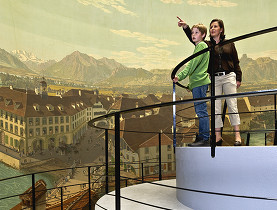Oldest “cinema” turns 200

Thun, in the Bernese Oberland, has just celebrated the 200th birthday of the world's oldest panorama.
Housed in an unimposing circular structure, the first “cinema” shows the city on a sunny day in 1809.
The rotunda stands concealed in Thun’s Schadau park, near Lake Thun. Virtually no one is aware that it contains a priceless jewel.
“We are very thankful that the panorama is still in a good state of repair,” said Jon Keller, Thun city archivist. “Because photography had not yet been invented in 1800.”
The panorama picture by Marquard Wocher measures 7.5 by 38.3 metres and is very detailed, according to Keller, who has been giving tours for the past 37 years. He often discovers new details in the circular painting.
Here and there he points out little scenes, which the eye can miss the first couple of times the picture is viewed. For example, there are some women doing their washing in the River Aare.
“I love this detail,” he commented. The scene from everyday life shows how difficult life was before the invention of the washing machine and before houses had running water.
Unique
The unique monument provides important information about the town at the start of the 19th century, according to art historian Dominik Imhof, the curator of the Wocher panorama.
“There is no other panorama image with the same subject matter,” he said. “Marquard Wocher painted quite an idyllic image of one morning in Thun.”
All other remaining panoramas depict battles, or historical or religious events, he said.
“And it is now the oldest preserved panorama in the whole world. That makes it a jewel of its kind.”
The people of Thun must have been amazed when they saw Wocher building a platform above the town’s rooftops and then starting to draw.
Unfortunately, there are no surviving eyewitness reports.
Up on the roof
“He made sketches up there and three large watercolours,” explained Imhof. These served as studies for the large panorama he painted in Basel. It was done in oils on paper and then attached to a canvas backing.
“This panorama is like a photo for us, a one-off item of historical record,” said Keller.
“We have letters from Basel in which he asks if a particular house roof has one or two chimney pots.”
It is debatable whether such details are important or not. “But it was important to Marquard Wocher,” said Keller. “He wanted to paint accurately. So this panorama is for us historians as important as a photograph.”
After five years work, the artist put his work on display in a rotunda in Basel from 1814. It was the first panorama in Switzerland.
Forerunner of cinema
Panorama pictures were the latest fashion at the start of the 19th century.
“This was a commercial undertaking by Marquard Wocher himself,” said Keller. “He managed this panorama in much the same way as a cinema owner with his picture palace.
Wocher charged visitors quite a high entrance fee, “but people then were quite prepared to pay, because it was such a sensation. And he lived on the proceeds”, according to Imhof.
“In his day this was like today’s Hollywood blockbuster,” he added.
It is therefore legitimate to see the panorama as the forerunner of the cinema, the city archivist said. “Then when silent movies and then talkies came, that was the end of the panorama, as the moving image was more interesting than the still image.”
Tale of woe
How the panorama came to end up in Thun from Basel is a story in itself. While many panoramas were forgotten about following the arrival of cinema, the city of Basel made a gift of its panorama to the Bernese town in 1899.
It was displayed at a national exhibition in the summer of 1943, but was then put into storage in a cellar under a school gymnasium and was forgotten.
And there it stayed until the 1950s when the former city architect Karl Keller (no relation of Jon Keller) discovered it during renovations. He ensured that the picture was housed appropriately.
A search for a location was launched and in summer 1961 the rotunda was finally inaugurated in the Schadau castle park. The Thun panorama had truly found its way home.
Christian Raaflaub, swissinfo.ch (Adapted from German by Morven McLean)
The view of Thun shows a perfectly ordinary morning in the small lakeside town.
If you look carefully, you can see more than 300 figures in all kinds of different situations.
There are people looking out of many of the windows, some of them directly at the observer.
Marquard Wocher even put himself into the picture, although only seen from behind.
Since 1960 the picture has belonged to the federal Gottfried Keller Foundation.
World wide, 21 panoramas still survive from the period before 1900.
Marquard Wocher was born in Mimmenhausen near Salem in southern Germany in 1760.
He moved to Switzerland in 1779, living at first in Bern, where he worked as a portrait painter among other things.
He moved to Basel in 1782, and married there in 1800. The marriage remained childless.
He worked on the Thun Panorama from 1809 to 1814, presenting it to the public in Basel in 1814.
In 1828 he ran into financial difficulties and tried, but failed, to auction it off.
He died in poverty the following year and the picture was sold.

In compliance with the JTI standards
More: SWI swissinfo.ch certified by the Journalism Trust Initiative











You can find an overview of ongoing debates with our journalists here . Please join us!
If you want to start a conversation about a topic raised in this article or want to report factual errors, email us at english@swissinfo.ch.